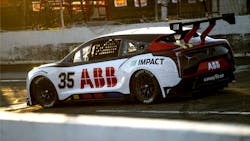Taking Electrification to the Track: ABB Races into Action with NASCAR
Formula One dominates globally, but NASCAR is the motor racing sport of America, with a down-home connection to the old souped-up 8-cylinder stock cars of yore.
Taking competition and skill to the edge never gets old and never begs for an audience.
“Auto racing, bull fighting, and mountain climbing are the only real sports,” iconic author Ernest Hemingway reportedly said. “All others are games.”
America gets it, and electrification giant ABB knows that NASCAR’s connection to fans from every walk of life offers the opportunity to champion energy transition and decarbonization in engaging and surprising new ways. The company has become a founding partner of NASCAR IMPACT, which is a new platform for driving sustainability initiatives across the stock racing map.
First step was ABB’s involvement with NASCAR’s new electric vehicle (EV) prototype. This cutting-edge racing-level EV was revealed when the two parties announced the ABB NASCAR Electrification Innovation Partnership and shown off at the 2024 Chicago Street Race this summer.
Taking sustainability to the racetrack
Such a move alone doesn’t push the energy transition to the finish line, but it turbocharges some new public recognition around the corners.
“We take that car to our shows, and most people recognize NASCAR and are fans of NASCAR,” Ralph Donati, executive vice president for ABB’s Installation Products Division in the U.S. and Latin America, said in an exclusive interview with EnergyTech.com. “NASCAR has its own sustainability initiatives, and we’re partnering with them to get there.”
Now the races themselves are not going electric any time soon, no surprise, as NASCAR recently reasserted its commitment to internal combustion engines (ICE). But the nation’s preeminent auto racing association owns many of the historic tracks where races are run and wants them to be more energy efficient and cleaner emitting.
“We’ll take a look at the different tracks and see what we can do,” Donati noted. “Daytona is different from Darlington (South Carolina) which is different from Martinsville (Virginia). We make low-voltage switchgear, so can we make the gear more efficient at the stadiums? Maybe there are opportunities to go solar in some places.”
NASCAR is steadfastly ICE on the tracks but wants to be cleaner in the venues and in-between.
“They really want to look at all of the operations,” Donati added. “How can they electrify everything?”
Decarbonizing NASCAR in-between the races
This could involve better and more efficient ways to power track jet driers, for instance, or even electrify the long-haul trucking from stadium to stadium.
ABB is neither a solar panel manufacturer nor an EV drivetrain or battery maker. What the company is focused on is the equipment which moves, secures and controls those electrons in safe and efficient ways. For example, the NASCAR EV prototype was developed by Chevrolet, Ford and Toyota, but ABB contributed more than 100 Ty-Rap Cable Ties and other ties to secure and protect EV parts at high performance levels.
Fleet and personal transportation electrification is a commitment by ABB through the long haul, from supplying EV charging infrastructure to sponsoring the global Formula E race car series. The 11th season of Formula E takes off with the starting gun this December in Brazil and continues in the U.S. with an April 12 competition in Miami.
The cars are nice but it's ultimately about people and jobs
NASCAR has evolved from humble dirt-track routes to the prime-time spotlight. What ABB also hopes to get out of the partnership is something truly down-home: educating a new generation on all the jobs needed in the once and future energy transition.
And the time is now. Generation demand is growing exponentially from new data centers propelled by artificial intelligence training capacity requirements, cloud-based hyperscale growth, fleet and industrial electrification and, of course, a steadily growing EV market. The utility grid we have now is amazing, but not up to speed for what’s coming.
“Some of the stuff is 40, 50 and 60 years old,” Donati pointed out. “We need to not just update the grid but expand and harden it.”
And the electrification companies, including ABB, need to reach a new generation of potential engineers and electrical contractors. Co-branding with NASCAR helps raise that profile.
“We definitely have a shortage, especially with the current generation retiring,” Donati said. “There’s definitely a gap when it comes to engineers, electrical contractors and linemen. It’s going to be a gap for 10 to 20 more years.”
Traveling with NASCAR, like a good race, can close that gap fast.
Track new developments in e-mobility and the C&I Energy Transition
Subscribe to our free EnergyTech E-Newsletter
About the Author
Rod Walton, EnergyTech Managing Editor
Managing Editor
For EnergyTech editorial inquiries, please contact Managing Editor Rod Walton at [email protected].
Rod Walton has spent 17 years covering the energy industry as a newspaper and trade journalist. He formerly was energy writer and business editor at the Tulsa World. Later, he spent six years covering the electricity power sector for Pennwell and Clarion Events. He joined Endeavor and EnergyTech in November 2021.
Walton earned his Bachelors degree in journalism from the University of Oklahoma. His career stops include the Moore American, Bartlesville Examiner-Enterprise, Wagoner Tribune and Tulsa World.
EnergyTech is focused on the mission critical and large-scale energy users and their sustainability and resiliency goals. These include the commercial and industrial sectors, as well as the military, universities, data centers and microgrids. The C&I sectors together account for close to 30 percent of greenhouse gas emissions in the U.S.
He was named Managing Editor for Microgrid Knowledge and EnergyTech starting July 1, 2023
Many large-scale energy users such as Fortune 500 companies, and mission-critical users such as military bases, universities, healthcare facilities, public safety and data centers, shifting their energy priorities to reach net-zero carbon goals within the coming decades. These include plans for renewable energy power purchase agreements, but also on-site resiliency projects such as microgrids, combined heat and power, rooftop solar, energy storage, digitalization and building efficiency upgrades.



